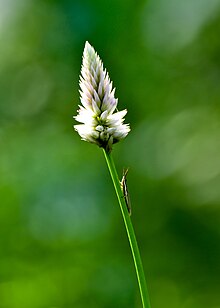Celosia
| Celosia | |
|---|---|

| |
| Celosia spicata | |
| Scientific classification | |
| Kingdom: | Plantae |
| Clade: | Tracheophytes |
| Clade: | Angiosperms |
| Clade: | Eudicots |
| Order: | Caryophyllales |
| Family: | Amaranthaceae |
| Subfamily: | Amaranthoideae |
| Genus: | Celosia L.[1] |
Celosia (/siːˈloʊʃiə/ see-LOH-shee-ə[2]) is a small genus of edible and ornamental plants in the amaranth family, Amaranthaceae. Its species are commonly known as woolflowers, or, if the flower heads are crested by fasciation, cockscombs.[3] The plants are well known in East Africa's highlands and are used under their Swahili name, mfungu.
Taxonomy
The generic name is derived from the
Uses
As a garden plant
The plant is an annual. Seed production in these species can be very high, 200–700 kg per hectare. One ounce of seed may contain up to 43,000 seeds. One thousand seeds can weigh 1.0–1.2 grams. Depending upon the location and fertility of the soil, blossoms can last 8–10 weeks.[citation needed]
As food
Celosia argentea var. argentea or Lagos spinach (a.k.a. quail grass, soko, celosia, feather cockscomb) is a broadleaf annual leaf vegetable. It grows widespread across Mexico, where it is known as "velvet flower", northern South America, tropical Africa, the West Indies, South, East and Southeast Asia where it is grown as a native or naturalized wildflower, and is cultivated as a nutritious leafy green vegetable. It is traditional fare in the countries of Central and West Africa, and is one of the leading leafy green vegetables in Nigeria, where it is known as "soko yokoto", meaning "make husbands fat and happy".[7] In Spain it is known as "Rooster comb" because of its appearance.[citation needed]
As a grain, Celosia is a
These leaves, young stems and young inflorescences are used for stew, as they soften up readily in cooking. The leaves also have a soft texture and a mild spinach-like taste.[citation needed]

Cultivation

Despite its African origin (a claim that is not without dispute), Celosia is known as a foodstuff in Indonesia and India. Moreover, in the future it might become more widely eaten, especially in the hot and malnourished regions of the equatorial zone. In that regard, it has already been hailed as the often-wished-for vegetable that "grows like a weed without demanding all the tender loving care that other vegetables seem to need"; one person said of his time growing it as this: "Every place I have tried it, it grows with no work. We have had no disease problems and very little insect damage. It reseeds itself abundantly and new plants have come up in the immediate vicinity."[8]
Works well in humid areas and is the most-used leafy plant in Nigeria. It grows in the wet season and grows well while other plants succumb to mold and other diseases like mildew. Though a very simple plant, Celosia does need moderate soil moisture.[citation needed]
Cultural Symbolism
The genus Celosia is also recognized as an important cultural symbol in
Selected species
- Celosia argentea L.
- Celosia cristataL.
- Celosia floribunda A. Gray
- Celosia isertii C.C.Towns.
- Celosia leptostachya Benth.
- Celosia nitida Vahl
- Celosia odorata T.Cooke
- Celosia palmeri S.Watson
- Celosia spicata L.
- Celosia trigyna L.
- Celosia virgata Jacq.[9][10]
- Celosia whitei W.F.Grant
Formerly placed here
- Chamissoa altissima (Jacq.) Kunth (as C. tomentosa Humb. & Bonpl. ex Schult.)
- Deeringia amaranthoides (Lam.) Merr. (as C. baccata Retz.)
- Deeringia polysperma (Roxb.) Moq. (as C. polysperma Roxb.)
- Iresine diffusa Humb. & Bonpl. ex Willd. (as C. paniculata L.)[10]
Images
-
Celosia cristata. Common name yellow toreador.
-
Red cockscomb
-
A close view of red cockscombs
-
Celosia flower
-
Silver cockscomb Celosia argentea
-
Celosia cristata
-
Plumed cockscomb flower and an insect
-
Celosia cristata (Cockscomb)
References
- ^ "Genus: Celosia L." Germplasm Resources Information Network. United States Department of Agriculture. 2001-08-07. Archived from the original on 2012-10-10. Retrieved 2011-01-30.
- ^ Sunset Western Garden Book. 1995. pp. 606–607.
- ^ Chisholm, Hugh, ed. (1911). . Encyclopædia Britannica. Vol. 6 (11th ed.). Cambridge University Press. p. 628.
- Perseus Project
- ^ "Celosia argentea (Plumosa Group) 'New Look'". Plant Finder. Missouri Botanical Garden. n.d. Retrieved 4 January 2023.
- ^ "Celosia argentea". www.nparks.gov.sg. Retrieved 2023-04-06.
- ^ Yarger, Larry. "Lagos Spinach" (PDF). ECHO. Archived from the original (PDF) on 18 January 2017. Retrieved 2 February 2023.
- ISBN 978-0-309-10333-6.
- ^ "Celosia". Integrated Taxonomic Information System. Retrieved 2011-01-30.
- ^ a b "GRIN Species Records of Celosia". Germplasm Resources Information Network. United States Department of Agriculture. Archived from the original on 2009-01-20. Retrieved 2011-01-30.









